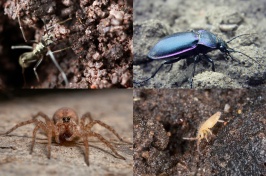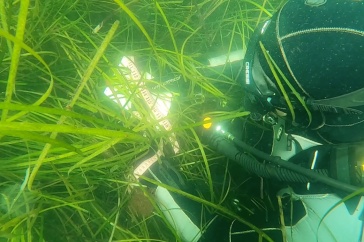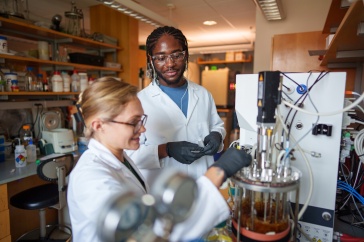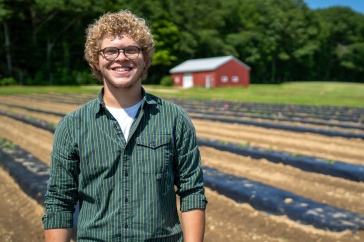Top row, LtoR/TtoB: This past summer, a team of UNH students worked with Hodgson Herbarium Collections Manager Erin Sigel to digitize the last portion of the herbarium’s Asian specimens. Pictured from left, Bryce Hegstrom ’23, Thomas Osborne, Owen Hughes, Rain Bugado and Sigel; Bryce Hegstrom works on mounting new specimens, preparing them to be photographed. Bottom row, LtoR/TtoB: Owen Hughes mounts a specimen that will be photographed and added to a digital, publicly available library showcasing the herbarium’s entire Asian collection; Rain Bugado pulls a mounted specimen from a machine that takes high-resolution images of each mounted specimen.
Project Goal:
To digitize the entire collection of the Albion R. Hodgdon Herbarium at the University of New Hampshire and make the collection publicly available online. A National Science Foundation grant, awarded in 2021, supported digitizing the Herbarium’s Asian collection, one step in the process. You can search through and view the specimens using several online portals, with the All Asia Thematic Collections Network coming in 2024.
Herbarium Deep Dive
Herbarium: A herbarium is a collection of preserved plant specimens, typically dried, pressed and mounted on sheets of paper, with accompanying labels providing information about the plant's identity, habitat and collection details, used for scientific study and reference. About 3,500 registered herbaria operate around the world, including 400 located in the United States.
What are herbaria used for?
Botanical research: Herbaria serve as valuable resources for botanical research, allowing scientists to study the morphology, distribution and diversity of plant species, aiding in taxonomy, systematics and conservation efforts.
Species identification: Herbarium specimens are crucial for accurately identifying plant species, especially when live specimens are not available or when studying historical records of plants in a specific region.
Education and outreach: Herbaria play a role in educating students, researchers and the public about plant biodiversity, ecology and the importance of preserving and understanding plant life.
This past summer, the Albion R. Hodgdon Herbarium at the University of New Hampshire moved closer to a completing a goal 13 years in the making: documenting its entire collection in digital format so that it can be publicly explored and viewed from anywhere with an internet connection. The last homestretch of this effort, which began in the 2010s under the leadership of herbarium Director Chris Neefus and has been overseen since 2021 by Collections Manager Erin Sigel, has involved digitizing the collection’s 3,800 Asia specimens as part of a National Science Foundation-funded collaboration among 25 herbaria across the United States, Europe and Asia.
“This grant allowed for a last big push to bring nearly the entire Hodgdon Herbarium collection of more than 213,000 specimens online and accessible to all,” said Sigel. “We have just a small portion of specimens left that aren’t viewable as high-resolution images, but the bulk of the entire collection can be thanks to this recent grant funding.”
“This funding supported similar efforts for herbaria across the globe that collectively curate millions of Asian specimens — very little of which has been digitized,” Sigel added.
Hodgdon Goes Digital
Over the past 13 years, the National Science Foundation (NSF) has funded the thematic digitization of herbaria, beginning with efforts to digitize all specimens from New England. In 2013, Neefus led one of these efforts to digitize all macroalgae specimens at 49 herbaria. It’s been through participation in these large-scale, collective efforts that the team at the herbarium has been able to digitize nearly its entire collection.
“There’s a huge push for digitizing these collections for a variety of reasons,” said Sigel. “One of the most basic applications is that people can now search online catalogues of these holdings and make requests for the physical specimens to use for their research or studies or to extract genetic information.”
She added, “But perhaps more importantly, because we’ve uploaded high-resolution images of our specimens, people can view the specimens entirely online and avoid physically requesting them, thus helping us better preserve the specimens. Plus, we’ve added metadata into the digitized catalogue, providing geographic information on where the specimens were collected and even ecological and historical data on each specimen — all of which is searchable.”
With this information, users of these online herbaria catalogues can easily determine what plants have been documented within a region, examine plant distribution change over time —especially important for climate change-related research — and even reference information on extinct plant species for their studies or projects. However, the physical specimens are still crucial for plant morphological and genetic studies, with new technologies capable of sequencing whole genomes from herbarium material, Sigel added.
Uncovering History
The NSF-grant has also supported imaging, databasing and georeferencing for previously uncatalogued species, including about 200 plants collected by UNH professor emeritus of plant biology Alfred Linn Bogle during a trip in the 1960s to India, Taiwan and the southeast Asian island of Borneo.
“When he was a young man, Dr. Bogle traveled around Asian collecting specimens from wherever he went,” said Sigel. “These specimens just sat, stored away at the herbarium, until now. Additionally, Dr. Bogle brought back multiple duplicates, so any duplicate copies we have from him we’ll send to other herbariums to add to their collections.”
Once complete, the NSF-supported All Asia Thematic Collections Network will provide the public with access to more than 15 million digitized Asian plant specimens, made available online at iDigBio.org. The project, part of iDigBio’s Thematic Collections Network (TCN), focuses on digitizing specimens from the unique and critically endangered biodiversity hotspots of Southeast Asia and the Himalaya-Hengduan region, according to the grant information.
This major digitization effort would not have been possible without the assistance of students, added Sigel. Over summer 2022 and 2023, a team of students including biology majors Rain Bugado and Thomas Osborne, recent biology graduate Bryce Hegstrom ’23, and music major Owen Hughes helped with the Asian specimen digitization at the herbarium.
“In my freshman year, I got to visit the Hodgdon Herbarium; after that, I decided I wanted to study plant systematics, and I’m fortunate I’ve been able to do that here,” described Bugado.
Osborne, who’s minoring in art, added that the opportunity to work on this project combined skillsets from both areas of his studies.
“I’m really interested in history, too, and it all ties into cataloguing and digitizing these specimens,” he added. “You have the biology of the plant, the data you can get on each specimen, as well as the historical context. With the Asian collection, the history is very important as we come across specimens from countries that no longer exist.”
“Then you also have the curatorial side of mounting and displaying each specimen, which is a bit artful,” Osbourne said. “It’s been a very multifaceted project.”
Following the digitization of the herbarium’s Asian specimens, the team’s next major project will be preparing to move the entire collection into a new and modern home at the renovated Spaulding Hall. The new space will offer more storage and display areas for both the herbarium and the UNH Collection of Insects and Other Arthropods and be located along a high-traffic section of Spaulding’s first floor.
“We’re calling the new area the Natural Histories Collection Complex,” said Sigel. “It’ll provide room for us to better showcase both collections and really highlight the care and craft that goes into curating our specimens — we’re really excited for the greater visibility, accessibility and educational opportunities offered in this new location.”
About the Albion R. Hodgdon Herbarium
Founded in 1892, the Albion R. Hodgdon Herbarium boasts a collection of more than 213,000 specimens, including vascular plants, macroalgae, bryophytes and lichens. Over the years, the herbarium — the largest of its kind in New Hampshire — has grown to encompass the most comprehensive record of the state's plant life, making it a vital resource for botanical research, education and outreach. The collection’s oldest specimen is over 200 years old. Beginning in 1936, the herbarium was directed by the prolific botanist and UNH professor Albion Hodgdon, who grew the collection from just 1,500 specimens to nearly 120,000 specimens.
In 2012, the herbarium initiated digitization efforts that have transformed its operations. By making this vast botanical knowledge accessible online, the herbarium is further solidifying its commitment to plant sciences and preservation. In 2024, the herbarium will relocate to its new space, co-located with the UNH Collection of Insects and Other Arthropods in the newly remodeled Spaulding Hall on UNH’s Durham campus.
Funding for the digitization of the Hodgdon Herbarium’s Asia collection was made possible through a National Science Foundation grant (NSF-2101884), Bringing Asia to Digital Life: Mobilizing underrepresented Asian herbarium collections in the US to propel biodiversity discovery, which was administered by the Harvard University Herbaria.
Learn more about the research taking place at the Albion R. Hodgdon Herbarium online. You can find online portals to access the entire collection on the herbarium website as well.
-
Written By:
Nicholas Gosling '06 | COLSA/NH Agricultural Experiment Station | nicholas.gosling@unh.edu






















































